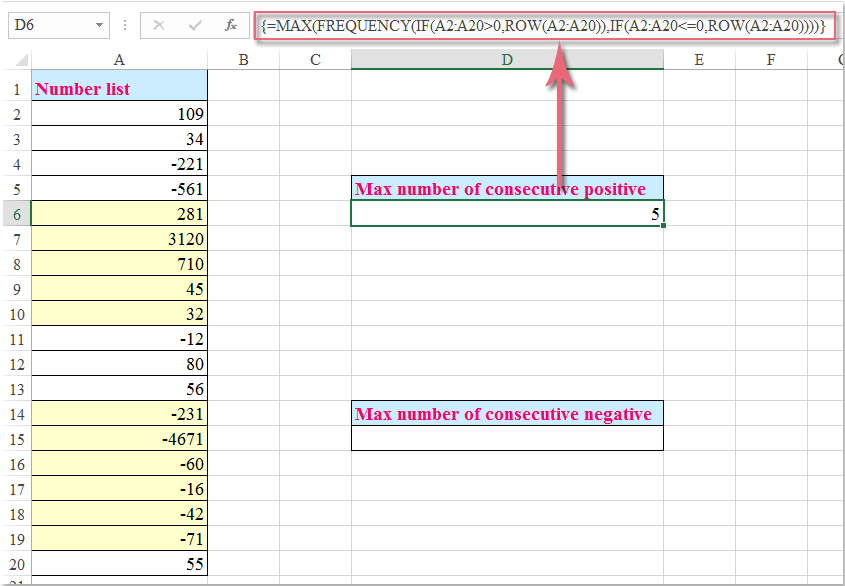Como contar o número máximo de números positivos / negativos consecutivos no Excel?
Se você tem uma lista de dados que mistura números positivos e negativos, e agora deseja contar o número máximo de números positivos e negativos consecutivos, conforme mostrado na captura de tela a seguir, como você lidaria com essa tarefa no Excel?

Contar o número máximo de números positivos e negativos consecutivos com fórmulas matriciais
Contar o número máximo de números positivos e negativos consecutivos com fórmulas matriciais
Para obter o número máximo de números positivos e negativos consecutivos, aplique as seguintes fórmulas matriciais:
Contar o número máximo de números positivos consecutivos:
Insira esta fórmula em uma célula onde você deseja obter o resultado:
=MAX(FREQUENCY(IF(A2:A20>0,ROW(A2:A20)),IF(A2:A20<=0,ROW(A2:A20)))), e depois pressione simultaneamente as teclas Ctrl + Shift + Enter, e você obterá o resultado correto de que precisa, veja a captura de tela:

Contar o número máximo de números negativos consecutivos:
Insira esta fórmula em uma célula onde você deseja obter o resultado:
=MAX(FREQUENCY(IF(A2:A20<0,ROW(A2:A20)),IF(A2:A20>=0,ROW(A2:A20)))), e depois pressione simultaneamente as teclas Ctrl + Shift + Enter, e você obterá o resultado de que precisa, veja a captura de tela:

Observação: Nas fórmulas acima, A2:A20 é a faixa de células que você deseja usar.

Desbloqueie a Magia do Excel com o Kutools AI
- Execução Inteligente: Realize operações de células, analise dados e crie gráficos — tudo impulsionado por comandos simples.
- Fórmulas Personalizadas: Gere fórmulas sob medida para otimizar seus fluxos de trabalho.
- Codificação VBA: Escreva e implemente código VBA sem esforço.
- Interpretação de Fórmulas: Compreenda fórmulas complexas com facilidade.
- Tradução de Texto: Supere barreiras linguísticas dentro de suas planilhas.
Melhores Ferramentas de Produtividade para Office
Impulsione suas habilidades no Excel com Kutools para Excel e experimente uma eficiência incomparável. Kutools para Excel oferece mais de300 recursos avançados para aumentar a produtividade e economizar tempo. Clique aqui para acessar o recurso que você mais precisa...
Office Tab traz interface com abas para o Office e facilita muito seu trabalho
- Habilite edição e leitura por abas no Word, Excel, PowerPoint, Publisher, Access, Visio e Project.
- Abra e crie múltiplos documentos em novas abas de uma mesma janela, em vez de em novas janelas.
- Aumente sua produtividade em50% e economize centenas de cliques todos os dias!
Todos os complementos Kutools. Um instalador
O pacote Kutools for Office reúne complementos para Excel, Word, Outlook & PowerPoint, além do Office Tab Pro, sendo ideal para equipes que trabalham em vários aplicativos do Office.
- Pacote tudo-em-um — complementos para Excel, Word, Outlook & PowerPoint + Office Tab Pro
- Um instalador, uma licença — configuração em minutos (pronto para MSI)
- Trabalhe melhor em conjunto — produtividade otimizada entre os aplicativos do Office
- Avaliação completa por30 dias — sem registro e sem cartão de crédito
- Melhor custo-benefício — economize comparado à compra individual de add-ins